Tessa’s Recipe Rundown
Taste: These cookies are bursting with nutty, toasty brown butter flavor without going too sweet.
Texture: This recipe nails that bakery-style contrast — a perfectly chewy center with crispy edges.
Ease: Browning the butter is an extra step, but otherwise, they’re super simple. You won’t even need a mixer!
Why You’ll Love This Recipe: These cookies are the perfect combo of gooey centers, crisp, golden edges, and a rich, brown butter flavor.
This post may contain affiliate links. Read our disclosure policy.
My Brown Butter Chocolate Chip Cookies are chewy in the middle, crisp at the edges, and full of rich, nutty flavor. The secret is browning the butter, a simple step that makes a big difference in taste and texture.
I’ll guide you through these step-by-step, but they’re pretty easy to master. You don’t even need a mixer to make these incredible cookies!
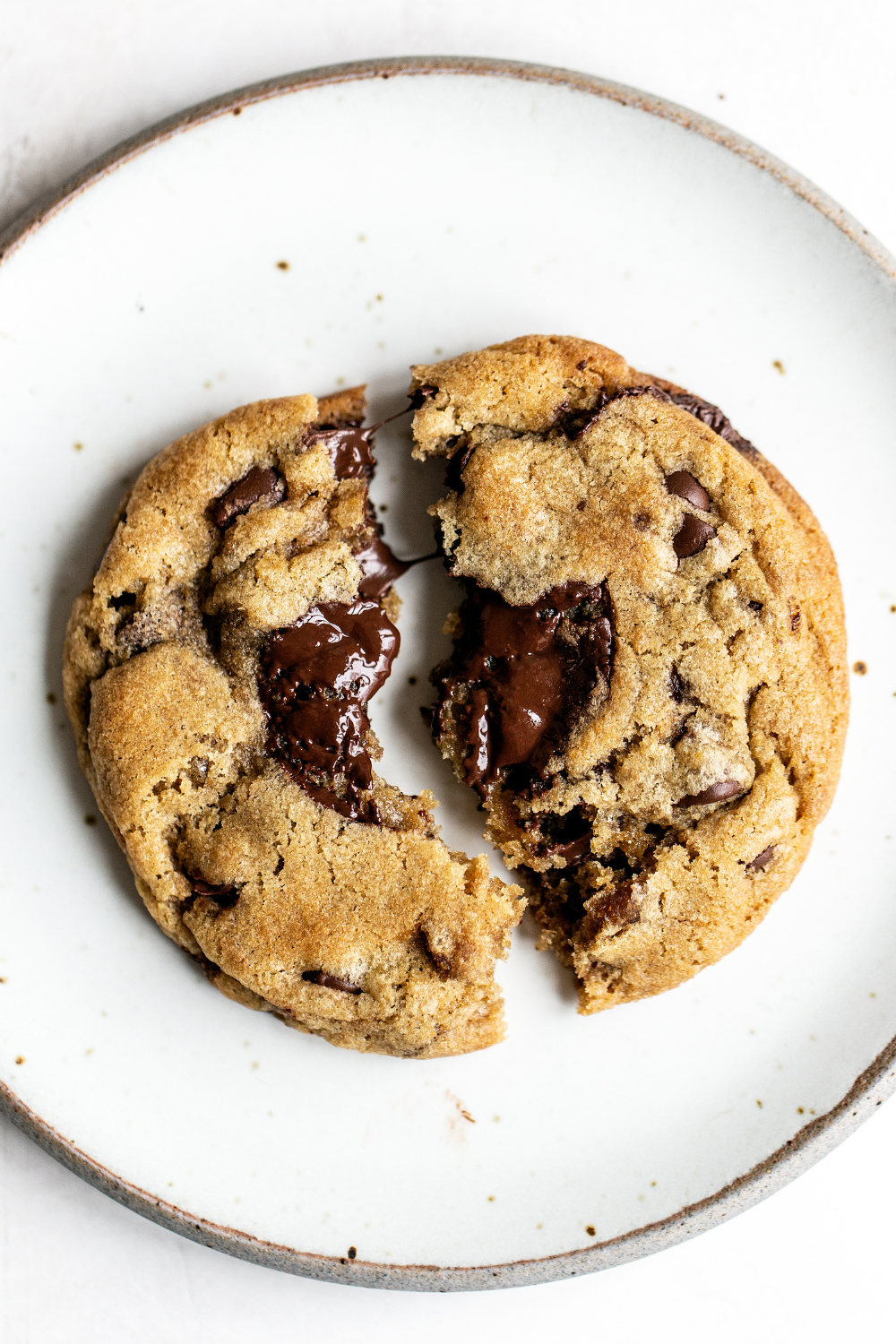
Reader Love
These are sooooo good, I’ve been baking for many years and this is the best chocolate chip cookie recipe I have tried. I chilled them for two days and the flavor was outstanding, I would recommend not skipping that part. Can’t wait to make them over the holidays!
–

Ingredient Notes
Every ingredient in the perfect chocolate chip cookie plays a role in that chewy, gooey, bakery-style texture. Here’s why they matter in this brown butter chocolate chip cookie recipe so that you can bake with confidence:
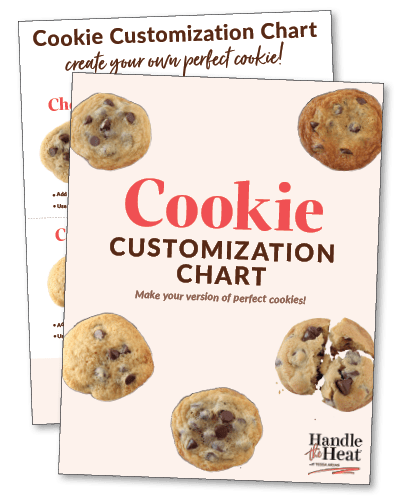
Struggling with Flat or Dry Cookies?
My free guide shows you how to fix texture problems and bake cookies you’ll love.
- Brown Butter: This is the star of the show! Browning the butter transforms its flavor, creating nutty, caramelized notes that give these cookies depth and complexity.
- Bread Flour + All-Purpose Flour: Bread flour has more protein, which results in a chewier, thicker cookie. If you only have all-purpose flour, you can use it for the full amount, but you’ll lose some chewiness.
- Dark Brown Sugar: This sugar adds rich flavor and moisture to keep your cookies soft and chewy. You can use light brown sugar (1:1 ratio), but your cookies will lose a little richness.
- Granulated Sugar: White sugar gives your cookies structure and just enough crispness for that perfect texture contrast. I strongly recommend that you don’t reduce the sugar in these cookies. Sugar doesn’t just sweeten, and cutting it out will change the texture of your cookies!
- Chocolate: This recipe combines chocolate chips and chocolate baking wafers (or fèves). The chips hold their shape, while the wafers melt into irresistible chocolate puddles.
- Sea Salt: This is optional, but you can add a sprinkling of flaky sea salt after pulling your cookies out of the oven.
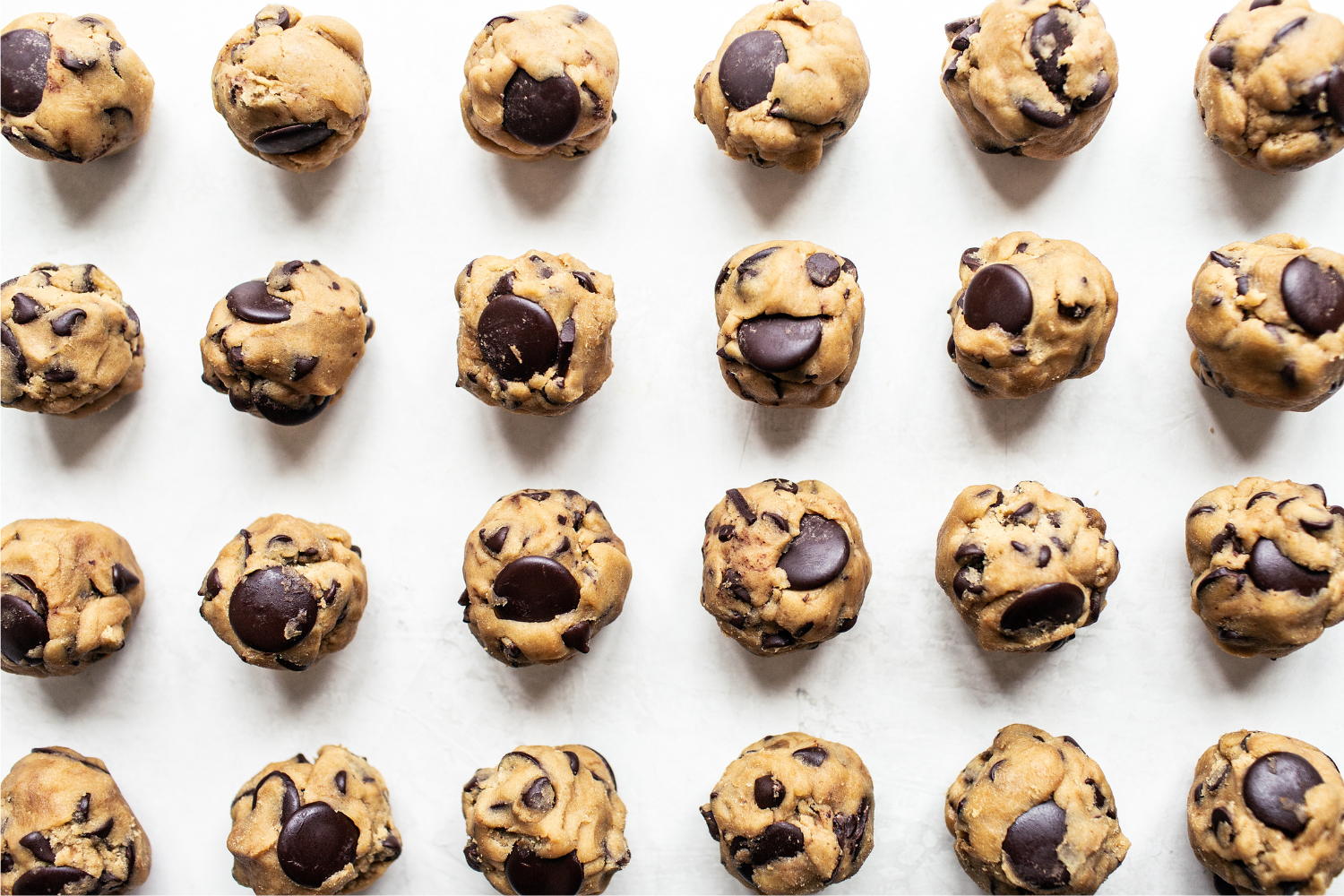

Sprinkle of Science
Step-By-Step: Brown Butter Chocolate Chip Cookies
I tested and tweaked this recipe until every batch had the perfect balance. These have gooey centers, chewy middles, and just-crisp edges. Here are my tips for cookies that are picture-perfect, taste great, but are totally doable at home.
1. Brown the Butter
I have hundreds of cookie recipes on my site, but there’s just something magical about brown butter cookies.
How do you brown butter for cookies? Start by melting butter, and then cook until the milk solids in the butter become toasted. The result is a deeply nutty, caramelized, butterscotch flavor that perfectly enhances chocolate chip cookies.
Brown butter is super simple to make. Just be sure not to walk away from it, as it can burn quickly. Scrape all the brown bits into the mixing bowl, too, as they’re the most flavorful.
Love the flavor of browned butter? Try these next: Brown Butter Pumpkin Chocolate Chip Cookies, Browned Butter Toffee Chocolate Chip Cookies, and Butterscotch Browned Butter Chocolate Chip Cookies.
2. Mix & Cool the Butter Base
After browning the butter, mix in the sugars and let the mixture cool completely before adding the eggs. This keeps the eggs from scrambling in the warm butter and helps the dough come together. Cool butter also thickens slightly as it sits, giving the cookies a chewier texture.
3. Build the Dough
Mixing the wet and dry ingredients separately is one of the easiest ways to get perfect cookies every time. Whisking the flours, baking soda, baking powder, and salt together first ensures even distribution of ingredients, so every cookie spreads and rises the same way.
When you gently stir the dry ingredients into the wet, you’re also less likely to overmix, keeping your cookies from getting too dense or dry.
4. Chill for Flavor & Structure
I know it’s annoying to have to wait to enjoy cookies, but I promise you it’s SO worth it. The dough improves in taste and texture as it chills. If you don’t want to wait for your cookies, feel free to bake a few after chilling for at least two hours, just to satisfy the craving. Bake the rest after 24 hours!
Freezing doesn’t work the same as chilling, so there are no shortcuts here. To fully develop the flavor and texture, it requires a minimum of 24 hours (and up to 72 hours) in the fridge.
5. Scoop, Size, and Bake
If my fridge space is more limited, I’ll refrigerate the entire mass of dough. If you do the same, you need to allow plenty of time for the dough to come to room temp before portioning. Don’t scoop cold dough. You’ll break your scoop!
I’ve found that this brown butter cookie dough is best as big cookies using a large 3-tablespoon cookie scoop. To make smaller cookies, use a medium 1.5-tablespoon cookie scoop and reduce the baking time to about 10 minutes. Note that the texture will be affected with a smaller scoop of dough.
The easiest option is to scoop and then chill. However, there’s a bit more risk that your dough will dry out in the fridge this way, so store the cookie dough balls in an airtight container or good-quality zip-top bag to prevent them from drying out.
Baking Tips for Best Results
From measuring your flour accurately to knowing exactly when to remove the cookies from the oven, a few minor tweaks can transform your results from “good” to “I can’t stop eating these.”
- Measure correctly. I use a digital kitchen scale to weigh my ingredients, especially flour. Incorrectly measured flour can lead to cookies that are tough, crumbly, dry, too thick, or just blah. If you don’t have one, use the spoon and level method.
- Check your oven temperature. Most ovens run a little hot or cold, which can throw off baking times. I use an oven thermometer to ensure baking accuracy.
- Choose the right pan. For best results, use a quality light-colored baking pan or cookie sheet and line it with parchment paper. The pan you bake on has a huge impact on your cookies. I have a guide to baking pans with side-by-side testing!
- Use fresh leavening agents. Make sure your baking soda and baking powder are fresh and active to ensure your cookies spread and rise perfectly. My guide explains these two leaveners and how to test for freshness.
- Don’t overbake. Bake these cookies just until the edges set and turn a golden brown. The middles may still look a little “wet,” and that’s OK! The pan’s residual heat will continue to cook them through to perfection.
- Chill the dough. I know I’ve already mentioned this, but don’t skip the chill period. Chilling gives the flavors time to deepen, resulting in thicker, chewier cookies.
Storage & Freezing Notes
When stored in an airtight container, these cookies stay soft and chewy for 2-3 days at room temperature. For longer storage, chill the dough for 24-72 hours first.
I like to portion out the dough and place it on a baking sheet, then freeze just until solid. Transfer the frozen dough balls to a freezer bag and freeze for up to 6 weeks. This way, you can bake off small batches of fresh cookies whenever you like!
FAQs
What makes this chocolate chip cookie recipe especially easy?
Even though these cookies look and taste bakery-worthy, the process is very approachable. No mixer is needed. Everything you need is easy to find at the grocery store, and browning the butter is easy to master.
How does browning the butter affect the flavor and texture of chocolate chip cookies?
Browning the butter transforms the flavor of your cookies in the best way. It develops rich, nutty, almost caramel-like notes that deepen the overall flavor, giving your cookies a more complex taste.
On the texture side, the dough has slightly less moisture, which helps create thicker, chewier cookies with crisp, golden edges. It’s a small extra step with a huge payoff in both taste and texture.
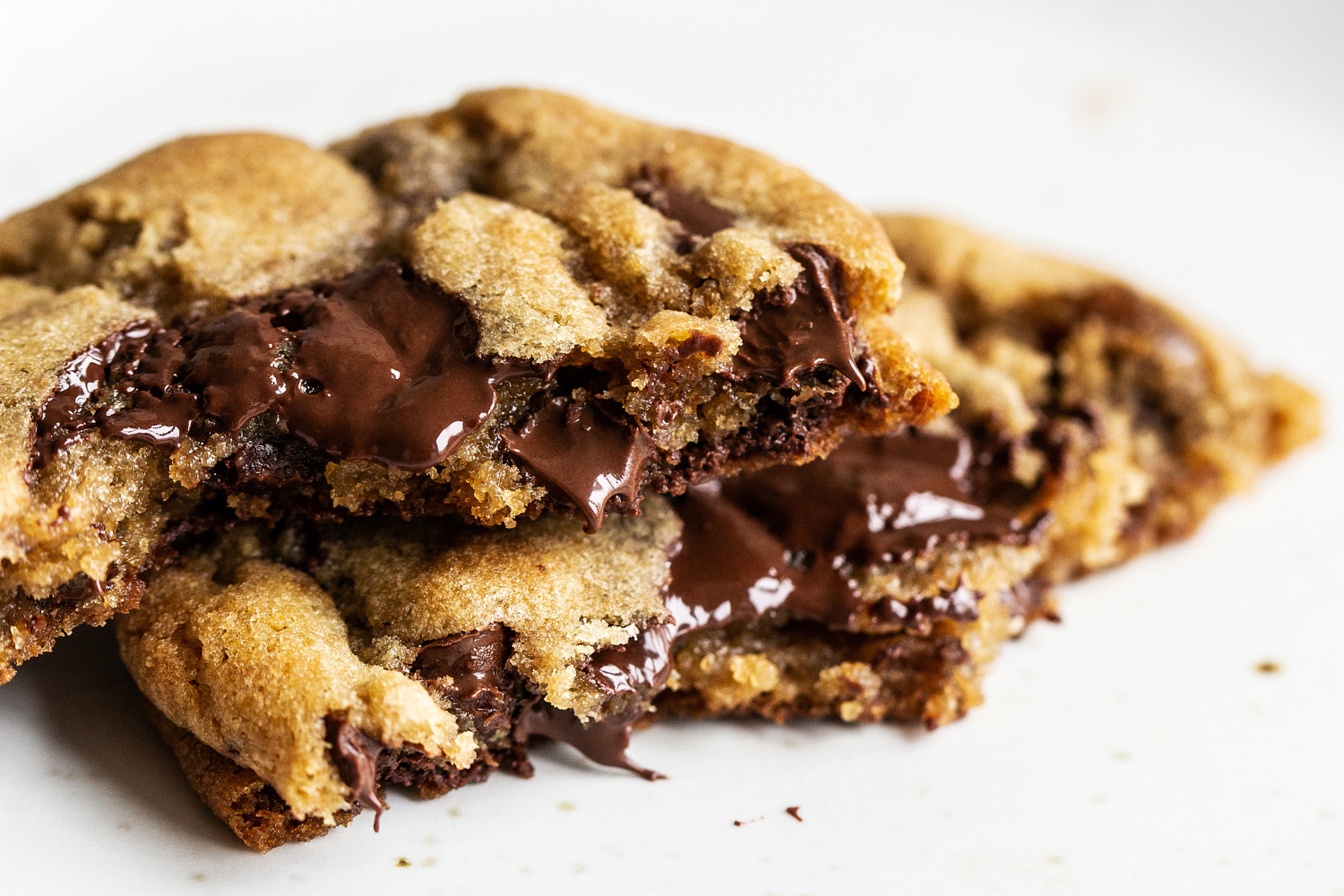
More Cookie Recipes to Try
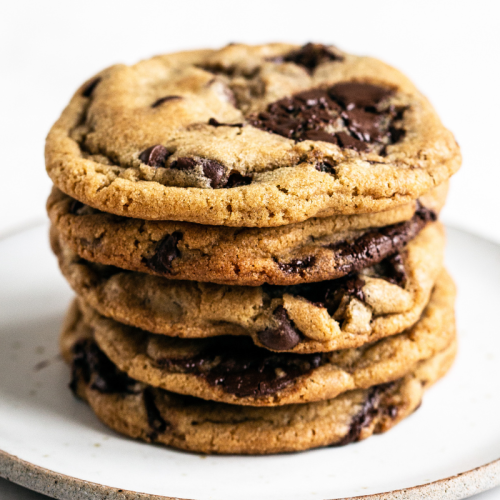
Browned Butter Chocolate Chip Cookies
Email This Recipe
Enter your email, and we’ll send it to your inbox.
Ingredients
- 2 sticks (227 grams) unsalted butter
- ½ cup (100 grams) granulated sugar
- 1 ¼ cups (250 grams) lightly packed dark brown sugar
- 1 ½ cups (190 grams) all-purpose flour
- 1 cup (127 grams) bread flour
- 1 teaspoon baking soda
- ¼ teaspoon baking powder
- 1 teaspoon fine sea salt
- 2 large eggs plus 1 egg yolk, at room temperature
- 2 teaspoons vanilla extract
- 1 ½ cups (255 grams) semisweet chocolate chips
- 1 cup (140 grams) semisweet chocolate baking wafers (from Guittard or Valrhona)*
- flaky sea salt (optional)
Instructions
- In a small saucepan set over medium heat, melt the butter. Swirling the pan occasionally, continue to cook the butter. It should become foamy with audible cracking and popping noises.
- Once the crackling stops, continue to swirl the pan until the butter develops a nutty aroma and brown bits start to form at the bottom. When the bits are amber in color, about 2 to 3 minutes after the popping stops, remove from heat and pour into a mixing bowl.
- Add in the sugars, stir, then set aside to cool completely.
- In a medium or large bowl, combine the flours, baking soda, baking powder, and salt.
- Add the eggs, egg yolk, and vanilla to the browned butter mixture, and stir with a rubber spatula until combined. Slowly stir in the flour mixture until just combined. Stir in the chocolate chips and wafers.
- Wrap the dough in plastic wrap and refrigerate for at least 24 hours but no more than 72 hours. Let the dough sit at room temperature until just soft enough to scoop.
- Meanwhile, preheat oven to 350ºF. Line baking sheets with parchment paper.
- Divide the dough into 3-tablespoon sized balls using a cookie scoop and drop onto prepared baking sheets, leaving about 3 inches between each piece of dough to spread.
- Bake for 11 to 13 minutes, or until golden brown. Sprinkle with flaky sea salt, if desired. Let cool for 5 minutes before removing to wire racks to cool completely.
Recipe Notes
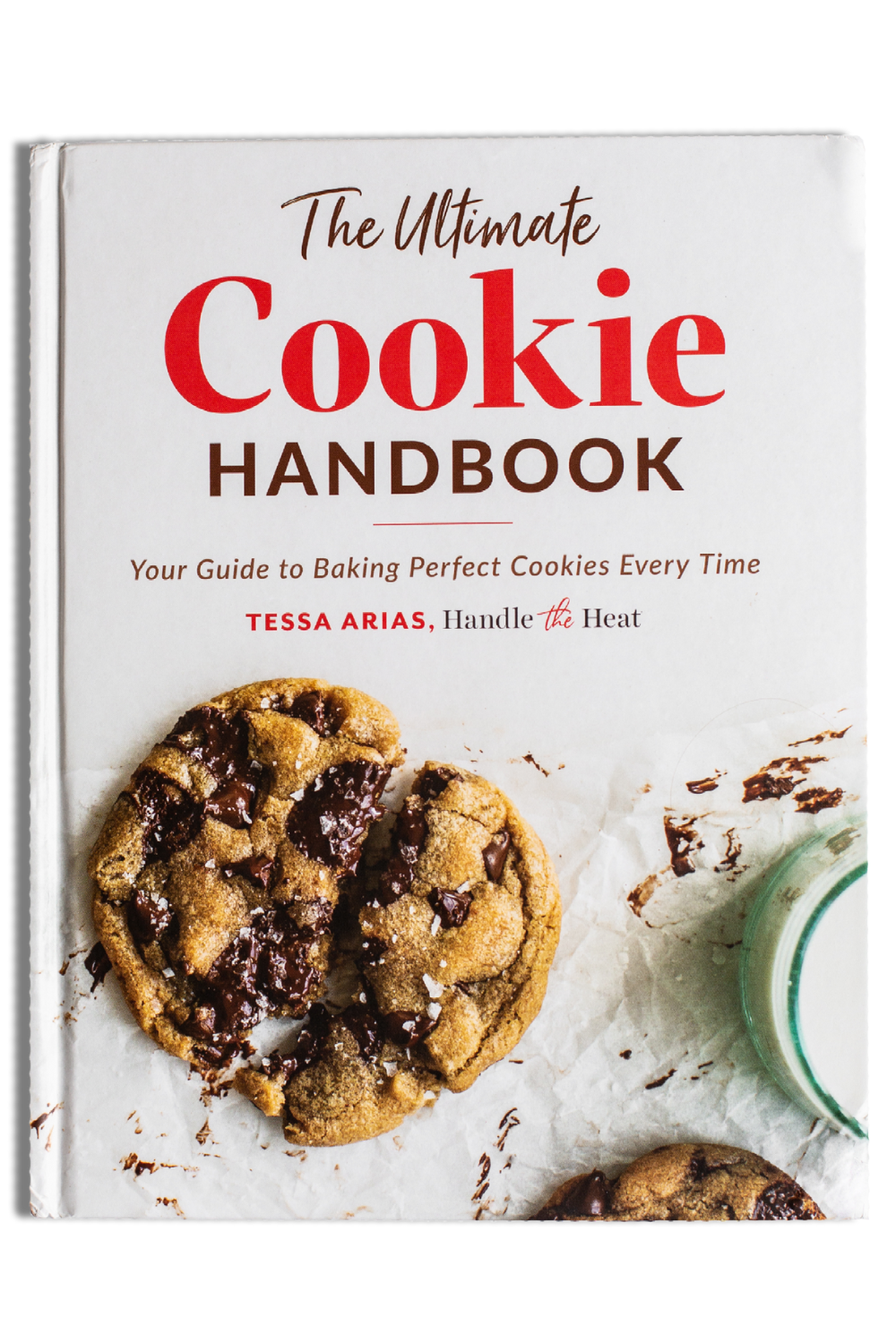
The Ultimate Cookie Handbook
Learn the sweet SCIENCE of cookie baking in a fun, visual way to customize your own recipes frustration-free. Plus, my best 50+ homemade cookies!
This post was originally published in 2015 and recently updated with recipe improvements and new photos. Photos by Ashley McLaughlin.
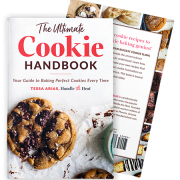
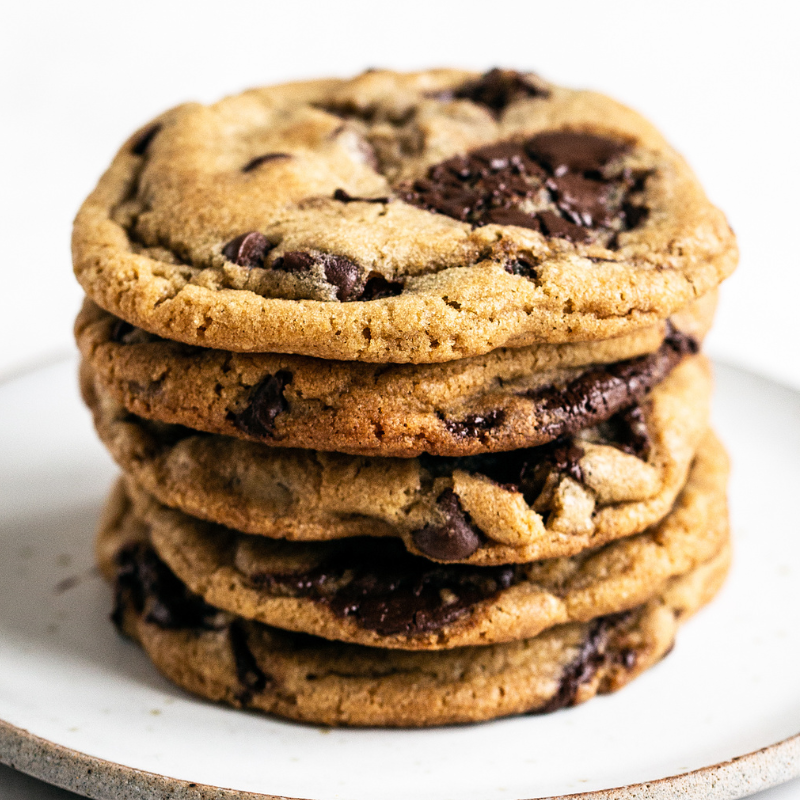
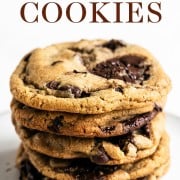
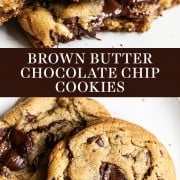

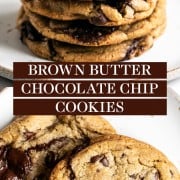


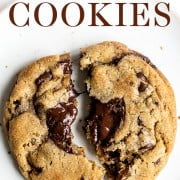



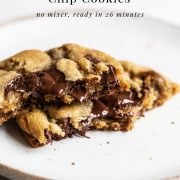
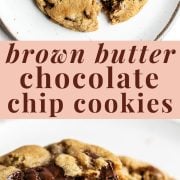

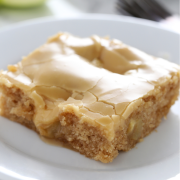
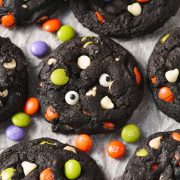
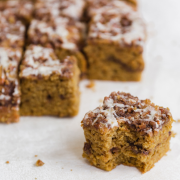



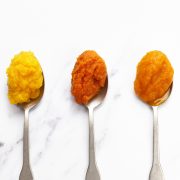











I only have aluminum-free baking powder. 1) do I need to alter the recipe if I use it? 2) is the freshness test the same as you mention in your article on Baking Soda vs. Baking Powder?
BTW, I don’t usually ask questions, but I really enjoy how well you answer them. Your knowledge and passion really shows! <3 <3 Thank you.
Hi Joanne! I’m so glad you enjoy the way our team answers questions! We all try to give the best baking knowledge we possibly can! 🙂
To answer your question, it depends whether or not your aluminum-free baking powder is double-acting or not. Aluminum-free baking powders are sometimes only single-acting, which means they primarily react only with liquid, which makes them react more quickly than most double-acting powders. Double-acting baking powders react with both liquid and heat, which slows the process down, and means they will maintain leavening power, even after your dough has chilled for a length of time. Because these particular cookies contain melted, browned butter, it’s very important that the dough be chilled for at least 24 hours, not just to greatly improve their flavor, but also to improve their structure. You can learn more about chilling dough and the associated benefits here! I believe that this lengthy chill time, if using a single-acting baking powder, would kill most of the rising/spreading power the leavener had, and your cookies therefore might not turn out well. Of course, you’re more than welcome to experiment and see if they still turn out okay – perhaps they’d just be a bit less puffy/flatter, but they may still taste good! There is no adjustment that we are aware of, if using a single-acting baking powder, that would make the cookies turn out exactly as they should. You could instead try using Tessa’s Bakery Style Chocolate Chip Cookie recipe, which doesn’t require refrigeration (although they are definitely better when the dough has been chilled a day or two).
If your aluminum-free baking powder is double-acting, no adjustments are needed and you can proceed with the recipe as written!
Aluminum-free baking powder can be tested for freshness the same way any baking powder can be. As you noted, this is explained in Tessa’s Baking Soda vs. Baking Powder article.
I hope this answers your questions! Feel free to reach back out if you have further questions – and let us know how your cookies turn out 🙂 Happy baking!
These are outstanding! And so, so easy. Love that they didn’t require a mixer. Definitely going to be on repeat at my house. I don’t keep bread flour on hand so I used all purpose for all of it. I made half after 20 mins of chilling and the other half after 24 hours of chilling. Don’t think I could tell the difference in a blind taste test. Both were soooo good. Brown butter for life!
tastes just like the whole foods brown butter cookie!
This is my new go to. First time didn’t refrigerate long but still were heavenly. The batch I just made I refrigerated not quite as long as you’re supposed to. I added Reese’s cups and Lindt white chocolate I had leftover to each and they’re super greasy— assuming because of those ingredient I added before baking. I think the truffle is a big oily and obviously the peanut butter is.
The rest of the dough is still in the fridge. Can I form it in to smaller balls and freeze for future use or is that not recommended?
Hi Ashley! Yes, you can absolutely roll the remaining dough into any sized balls you wish, and freeze in an airtight container for future baking. Learn more about that process (and how to bake from frozen) here! As for your greasiness issue, it could be that your mix-ins were a little greasier than regular chocolate chips, and it could also be from a shorter refrigeration period. A longer chilling time will give the flour more time to absorb the water content in the butter, creating thicker, less greasy cookies. If you continue to have issues with greasiness, I recommend trying out bleached flour (if that’s accessible to you – it absorbs more moisture than unbleached flours), and also perhaps try a different brand of butter, as some butters can be greasier than others. I hope something here helps, Ashley! Happy baking 🙂
These are my new favorite chocolate chip cookies. So good!
I rarely make the same cookie recipes more than once, but I have made these cookies four times now, and I am making more today to add to the cookies trays at one of our holiday parties.
When I took them to my son’s football banquet people were tracking me down to ask how to make them.
They are THAT good!
These are absolutely luxurious! I have the dough chilling now, but I needed to sample one by baking a few right away. Fabulous recipe!!
hi there! these look delicious 🙂 i was wondering if i can make these in the airfryer, and if so, what the temperature and size of the cookies should be? thank you!
Hi D! I’m sorry, but we have never tried baking any of our recipes in an air fryer! I think it would all depend on your specific model, size, etc, so you will need to do some experimenting. I’d recommend starting with one cookie and see how it goes 🙂 Be sure to chill your dough for at least 24-72 hours, too! Let us know how it goes!
I love this cookie recipe! I’ve made it several times and I never stop talking about it. However I do find they come out a little greasy, am I able to reduce the butter to make them less greasy?
Hi Jasmeaux! Hmm, these cookies shouldn’t be greasy. What kind of butter are you using? Butters with a high butterfat content (such as European style butters) can leave a slight greasy feel in some cookie recipes. Do you chill the dough for a few days, or at least 24 hours, before baking? Chilling for this extended period of time can help immeasurably with greasiness, as the flour has time to absorb more of the moisture, therefore making the cookie less greasy. You can read more about this here! Lastly, if you aren’t already, I recommend using a bleached flour for cookies. Bleached flour better absorbs moisture, compared to unbleached flour, which could also help combat this greasiness. Hopefully something here helped – and if not, feel free to reach back out so we can further troubleshoot together 🙂
I made these. The dough is sticky and went so flat in the oven. I froze tow balls for 2 hours and then baked them.
Hi Abeer! Unfortunately, these cookies need to sit in the fridge for 24 hours before baking, and freezing just can’t work the same magic! Find out more about why here!
These are great when made right, but many comments say they’re greasy/runny. It’s because there’s a typo in the weighed ingredients! AP Flour says 190 grams, but I think it should be about 300 grams! Please fix this, I’ve nearly ruined my batch twice when following the directions, but luckily I catch it before baking when I see how runny the dough was! I commented this once before but looks like the recipe was never fixed. Otherwise I love these cookies!
Hi Rachel! No, the recipe’s flour measurements are correct. 1 cup of flour weighs 127 grams, so the all-purpose flour measurement of 1 1/2 cups will weigh 190 grams (technically 190.5 grams), plus the additional cup / 127 grams of bread flour. After the mandatory chill period, these cookies will bake up beautifully soft and chewy, exactly as pictured. Be sure to check out all the tips and information in the pink tip box, above the recipe, for best results 🙂
I find this recipe too sweet. My throat hurt from the sweetness. Made me sad because I spent good money on the ingredients. Sorry.
Hi Martina! I’m sorry to hear that you didn’t enjoy these cookies. How do you measure your ingredients? By volume (using cups), or by weight (using a digital kitchen scale)? When measuring by volume, it’s so easy to mis-measure flour/sugar/etc and throw off the entire chemistry of a recipe – and end up with a baked good with the wrong consistency, too flat, or too sweet. Tessa talks about how to best measure ingredients to ensure accuracy every time, in this article here! I would also recommend using a darker or bittersweet chocolate in these, to balance the sweetness more, if you are sensitive to sweetness. I hope you give these cookies a try another time – they really are delicious! Happy baking 🙂
very yummy